Unfortunately, I was unable to attend the 50s Bikeway open house event last week (we were sorta busy). If you were at the event, can you share your impressions with us? If you missed it, yet are still interested in learning more about this major bikeway project, PBOT has uploaded all the poster boards displayed at the event so you can take a virtual open house.
Given that the only coverage I’ve given the event was a brief mention yesterday that focused only on the “haters,” I don’t want folks to get the impression that there’s a lack of support for the project. In fact, from what I’ve read and heard, the opposite is likely true.
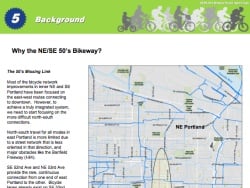
City staff isn’t ready to release the contents of all the feedback they’ve received, but PBOT project manager Rich Newlands shared with us just how much feedback they received. According to Newlands, 154 people signed in (“we are very pleased with the turn out”), around 250 comments were received at the various comment stations, and approximately another 50 emails have been received (and counting) before and after the open house.
It will be interesting to find out the overall tone of the comments. My hunch tells me that the potential space re-allocation (parking removal) in the southern portion of the alignment will be the biggest issue (we delved further into that a few weeks ago).
PBOT has uploaded all the poster boards that were on display at the event. You can download them from the 50s Bikeway Project webpage to study up before the next open house.
This project is a big deal. It’s been 13 years in the making, and it will become a major artery in our bikeway system for decades to come.
Again, I’d love to hear from anyone who went to the event. What is your sense of how strongly this project is supported — or reviled — by the surrounding community? Thanks for sharing.


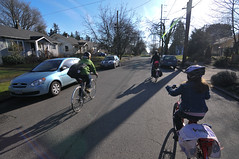
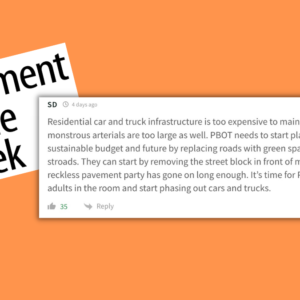
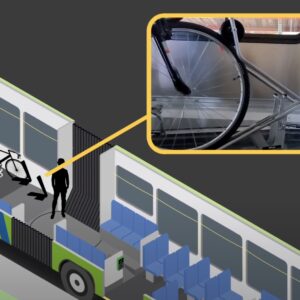
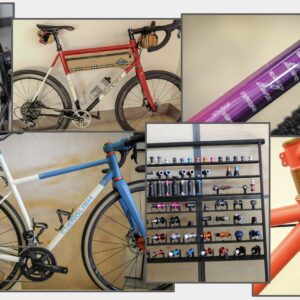

Thanks for reading.
BikePortland has served this community with independent community journalism since 2005. We rely on subscriptions from readers like you to survive. Your financial support is vital in keeping this valuable resource alive and well.
Please subscribe today to strengthen and expand our work.
I was there. It seemed like there were two options for the route that the bike path would take. Option A was primarily along 52nd, and used a main street for travel. Option B meandered through quieter neighborhoods several blocks east of 52nd. It was a very circuitous path.
It seemed to me, that to cyclists in attendance, the direct route of Option A was attractive. Local residents who were averse to losing parking or slower speed limits were in favor of Option B.
I overheard several planners talking, and they were quite pleased that in general the comments were very well directed at the project, not rants about spending public money on bikes, etc. I saw more positive comments about the bikeway than negative, but both sides of the story were certainly present.
I really hope that Option A happens, as it will make my commute north to Clinton much nicer than it is now. As it currently stands, crossing foster, powell, and getting to Clinton is probably the riskiest part of my day.
My big concern with Option B is that it would be invisible to anyone who doesn’t live on the route itself. I learned about the “Center Street Connector” while I was there. It is a similar route on residential streets, and only two blocks from my house. Apparently it has been there for a year and I didn’t even know. Option A would put a high profile bikeway in a part of town where there are a lot of bikes. It probably won’t be as busy as Clinton, but having it this visible is certain to get potential bikers started with a clearly accessible route.
Mike,
Totally agree with you that Option A is much preferred by most cyclists–it’s more direct, has more controlled intersections, and avoids extremely difficult crossings at Foster (on 56th) and Powell (54th, I believe).
But my impression was that PBOT would actually like to do both, as they are betting that A would still not be a very comfortable ride for “nontraditional” cyclists, e.g., families, because the speed limit on 52nd will likely not be lowered. But I heard from an advisory committee member that they if they only build one, it will likely be A.
I have some other problems with the B route; it uses some very narrow streets and goes through some problematic areas where cars go very quickly connecting from Foster to 52nd. (Boise St. in particular.) I used to live in that area and it is clear PBOT will need to adjust speed limits or add traffic control in those areas to prevent that speeding cut-through traffic.
I didn’t go to the meeting. Looking at the routes over the past week, I keep thinking- as someone cycling now, option A looks great. However to attract more cyclists, we need to build option B (maybe not in this case right now, but in general). Perhaps, we should build both.
In inner NE, Broadway/Weidler is great, but having Tillamook a few blocks away gives those who don’t want to be out in traffic another option. Everyone should have choices. Was anyone in favor of building both? Just my thoughts
I’ll be forwarding more info to AROW. Over all it was… interesting. I didn’t know there was an option B complete with alternative versions until I read through all the poster stations. I got lost getting to the open house, and apparently my weaving in and out of neighborhood streets route is similar to the option B route. I’m a pretty competent rider, fearless, year round, all weather type, and yet I am still obviously very dependent on street markings and signs directing people on bikes.
The overall tone from the advisory committee members and staff I talked to seemed pro bike and pro option A. I saw quite a few children at the event and a lot of bikes with childern carring capacity out on the racks. Apparently there are a few families out there who would be happy to get the same kind of treatment we get here in the inner neighborhoods. With the lack of connectivity in these neighborhoods either options would be a blessing, and I would hope that someday both Options become, well, an option.
Thanks for the update, Jonathan.
Michelle has a write up on her experience at the open house here: http://www.activerightofway.org/?p=632
What no one has commented on is there are two options for the bike lanes on 52nd in the southern section. One is to remove parking on one side, resulting in 6 foot bike lanes. The other is to remove parking on both sides, and install 8 foot buffered bike lanes! I’d definitely prefer that.
Of course, that would be much harder to sell. I talked to one woman whose house on 52nd had a shared driveway, hence no driveway parking, her husband was a contractor (need truck parking?) and she was pregnant, and didn’t want to have to walk to the nearest intersecting street. While one side parking instead of none would perhaps help this resident, to access parking across the street, you’d have to walk to the intersecting street anyway to legally cross. (Unless the blocks are more than 300 feet long).
Seemed to me that those with both positive and negative feelings were represented. I think most people who I observed were reserving judgement and primarily there to gather information about the plan more than anything.
Has there been any suggestion of a bicycle track, similar to the one on SW Broadway? There seems to be enough room (6 ft each side) and that would allow a greater feeling of safety for those who are uncomfortable with bike lanes.
I work when most meetings take place, so I should probably share my thoughts with the right people as well, but here’s a few things to chew on anyway..
I own a home near 72nd and Woodstock, and use 52nd as part of my commute to Williams and Fremont. South of Woodstock, it is already a bike lane with no parking, and it would be logical to extend that north at least to Foster/Powell. We’d lose the corral in front of Toast, but it could be moved to the adjacent parking lot maybe. In the process of restriping, adding a left turn only lane at Steele would be a big help too. I think if the goal is to provide a real transportation corridor for bikes, option A is the only really viable one. I may be a seasoned commuter, but I don’t ride a lot of “greenways” because they simply take too long to get through. My commute is long enough to really appreciate direct, quick routes which save me time and energy, even if I am exposed to more car traffic. Basically, I would still use 52nd even if option B were decided on.
As for the concerns of some neighbors, and the ones specifically mentioned above – non driveway parking can be found on intersecting sidestreets. I would imagine the pregnant lady’s temporary condition will pass before the project becomes reality. If I owned a home on 52nd, I would advocate to have the whole street closed to motor vehicles simply to get rid of the noise. 72nd is about the same in this regard, and I wouldn’t mind it there either.
It would be impossible to please everyone with this project, but I think there would be a lot of improvements to traffic flow on 52nd with the removal of parking. All the adjoining neighborhoods would be greatly benefited with a viable bike route north as well, outweighing the cry of whiners. Relegating bikes to meandering, slow side streets is giving us second class treatment, not respecting our equal rights to the roads.
Interesting that you mention “equal rights to the roads” in your post, but then also suggest closing a street to motor vehicles. Why is it both sides think that it’s only the others who whine?
Sometimes it’s appropriate – many of the freeways in Portland are closed to non-motorized traffic because it’s too hazardous to throw bikes in the mix. Why should it be a surprise (or be unequal) to say the same is true on some streets for motorized traffic?
Considering that there are already many, many roads that have no bicycle access whatsoever, either by law (most freeways), or by practical access, and even more roads that have no sidewalks or safe access to people walking, I really don’t think you need to worry about car access.
If a road did have a restriction against car traffic, not a single human being would lose their right to the road, of course. They would just have their privilege to operate a piece of heavy machinery curtailed.
what roads besides freeways are bikes banned from?
not sure if you read my post but i suggested closing the street to motor vehicle traffic for the purpose of noise mitigation, not as a discriminatory measure. limiting the use of noisy, polluting, dangerous machines in the public space, though, is something i can almost always get behind anyway. promoting the use of quiet, safe, and health-inducing machines seems to me like a very good alternative.
I really close to where the event was held, at about 60th and Reedway. Just yesterday I took 52nd on my commute home (south from Clinton) and had the usual harrowing experience. Usually coming from downtown I just take 26th and then Steele up the hill. It’s not much better–a pretty steep climb with no bike lanes except for one small portion, and 30 mph limits on Steele–but at least there’s considerably less traffic, and drivers generally don’t seem to think of Steele as a speedway like they do 52nd.
The event last week was generally positive. I got the sense that there were some serious anti-bike folks there, but they were limited. I saw one older bearded guy writing comments from a typed-up talking points sheet; I believe I overheard him say he was from the Rose City Park neighborhood association. Another older bearded guy was videotaping his rather confrontational conversations with PBOT officials. A few others seemed to question the city’s statistics on ridership, etc.
Overall, though I was pleasantly surprised, especially given that I’ve just moved to this neighborhood. There were small conversations all over the room, including some between ardent cyclists and those who appeared more concerned about the project’s implications. People on both sides of the issue had the chance to see that their neighbors will be affected in one way or another, and to remember that ultimately we all want folks to get to their destinations safely. Yes, there is a solid cadre of people who do not want parking removed on 52nd–on the comments people were sticking to the map with Post-it’s I saw this quite a bit–but more of the comments I saw seemed to be focused on other suggestions for improvements, support for specific proposals, etc. Most of the folks present seemed to support Option A, though several people with families seemed to indicate B would be more enjoyable for them. I might even use B when out for a weekend ride, as opposed to commuting. I would love to see both options; if cars have so many safe ways to get where they intend to go, it makes sense that cyclists be given alternatives as well. I say that as someone who drives and bikes regularly.
That’s my two cents.
Here my take away:
Planning a decent bike way is hard work and can be a compromise at best:
– specially in this area of town, since most streets do not go through. That’s one of the reasons why 52nd is so busy and miserable to ride.
– topography can throw off the best planning: between Hawthorne and Stark the bike way will graze Mt Tabor which will be hard for cargo bikers, families etc. because leading it to the flatter upper 40’s will mean a big diversion and dealing with a slim traffic corridor (49th between Hawthorne and Stark).
What we should not forget is that while bike ways are nice to ride, we still have the right to pick the best route for us!
Yes, there where grumpy people, but I learned a lesson: Go and talk to them! As soon as they are no longer faceless ‘haters’ and you are no longer just one ‘biker’, a dialogue can begin.
I think the Pdot team did a great job!
“Go and talk to them! As soon as they are no longer faceless ‘haters’ and you are no longer just one ‘biker’, a dialogue can begin. ”
Exactly. The passion and fear is real, and it’s up to us to be leaders in communicating with the other side, recognizing fears, forgiving fears, and healing. Well said!
Honestly folks? Freeways typically have minimum speed limits associated with them. Not quite a fair comparison.
An honest question: what percentage of residential streets are off-limits to bicycles? If you primarily get around via bike and a citizens group stepped in and said that the street you live on was off-limits to bicycles, how would that go over with you?
Please understand that I’m looking for a straightforward discussion. I love bikes and I grew up with bikes — I was a bmx kid. I’ve had at least one bicycle in my life for more than 40 years now. (I actually restored and ride my Super Le Tour that I originally purchased back in ’85.) I might not get around town via bike as much as most here, but I certainly understand the concept.
I often think that those who expect the most special treatment are those who only entered (or re-entered) cycling as adults.
Interesting thought: I think what you are saying is that people who come to cycling late are timid and therefore need more space, quieter roads etc. (kind of the people-who-stop-smoking theory…)
There is probably that aspect, but there is also the thought that a general slowing down and roads with limited access actually benefit everybody, not only cyclists…
– Cutting down speed on main roads reduces severity of accidents, emissions and noise.
– Limited access streets allow alternative street use: Kids playing in front yards, rising property values due due better livability and better community ties.
I think that is what many of the pro bike way people actually have in mind.
One more point: Many of the cyclist there are actually utilitarian cyclist – cycling is part of their daily transportation, not just a sport. That tends to shift your perception: Just imagine riding your BMX bike everyday to work…
It sounds like Woodstock Cyclist saw Terry Parker and Jim Karlock (with his video camera) in action. They are at almost all public meetings on transportation, always questioning anything that does not support unfettered automobile use. I hear Karlock has a site where he posts all these videos (He’s filmed me when I’ve commented at meetings, so I’m probably on it!).
I attended the meeting and thought both options seemed really good. I would advocate that PBOT address all the issues on the routes in this planning and development stage, rather then doing too much compromising. It’s rather hard fixing issues to existing boulevards apparently. Having PBOT address the volume and speed issues on the existing Lincoln bicycle boulevard between 50th and 60th has been nearly impossible. I know Clinton has also had issues. So I would say make the tough calls now and piss a few people off. In the long run it will be loved by many more.